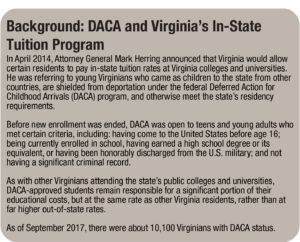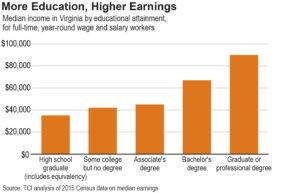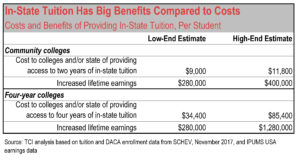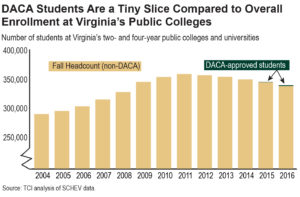January 2, 2018
In-State Tuition Is a Common Sense, Low-Cost Investment for Virginia
The availability of in-state tuition rates at public colleges and universities for Virginians provides a pathway to better jobs and opportunities that benefits students and the state economy. And looking at Virginia’s experience over the last three years, it’s clear that allowing Virginia students who have deferred action immigration status to pay in-state rates does not create a cost burden to the state or result in overcrowded classrooms.
During the 2015 legislative session, Virginia’s General Assembly recognized the importance of providing access to college for all Virginians and rejected a proposal that would have singled out a group of Virginians — those with Deferred Action for Childhood Arrivals status — and barred them from being able to pay in-state tuition rates.
Current uncertainty about the future of the Deferred Action for Childhood Arrivals (DACA) program creates the risk that young Virginians who are currently enrolled in Virginia colleges and universities could lose DACA status and therefore lose access to in-state tuition. State policymakers could mitigate the potential impact of this loss on DACA-approved students and their families by expanding in-state tuition access to Virginia residents regardless of immigration status. Doing so would also provide more affordable access to Virginia colleges and universities for Virginia residents whose immigration status does not otherwise fall into the categories currently required for in-state tuition. Twenty states, including Colorado, Oklahoma, and Texas, have made this choice in order to boost the educational attainment of their workforces and help all families in their states succeed.

Virginia’s experience with in-state tuition for young people with DACA status shows this access is important for students and their families, and is not creating overcrowding. Data from Virginia’s public colleges and universities, including Virginia’s community college system, show that enrollment by students who have DACA status has been modest. As of the 2016-2017 school year, there were 344 DACA-approved students attending Virginia’s four-year public colleges and universities and 982 at Virginia community colleges out of almost 400,000 total students. Of those DACA-approved students, 97 percent were Virginians who qualified for in-state tuition; the other 3 percent paid out-of-state tuition like other out-of-state students.
These enrollment numbers by students with deferred action status show that any concerns that Virginians with deferred action status would overwhelm Virginia’s public colleges are unfounded.
Moreover, being able to go to college can make a big difference in these Virginians’ lives and boost their ability to contribute to the state economy.
Big benefits for the students, their future employers, and Virginia’s economy
Not only does going to college make a difference in the lives of these individual students, it also makes them more productive future employees and Virginians. Obtaining a college degree — or even attending college but not completing a degree — provides skills and knowledge that leads to higher productivity, lower likelihood of unemployment, and higher wages.
The public funding that enables states to charge lower college tuition to their residents is a common-sense investment the state makes in young people. Lowering the cost barrier to obtain an education means more productive Virginians, helps employers find the workers they need, and strengthens the state’s economy. In exchange, young people — and their families — invest by paying a portion of college costs and spending thousands of hours studying and learning, developing skills that should boost earnings and job opportunities in the future. The state as a whole also benefits from this partnership, since workers who make decent incomes are able to provide more stability and opportunities for their own children.

Here in Virginia, full-time, year-round workers with a bachelor’s degree typically make $67,000 a year, compared to $35,000 for those without any education beyond a high school diploma or its equivalent. Over 40 years of work, that’s an extra $1.3 million in earnings for the typical worker with a bachelor’s degree.
Workers and the economy also benefit from more people achieving two-year associate’s degrees, which are often designed to provide skills for occupations with many unfilled jobs. On average, Virginians with an associate’s degree who are working full-time, year-round make $45,000 a year, well above the average of $35,000 for those with only a high school diploma or equivalent. Over 40 years of work, that’s an extra $400,000 in lifetime earnings.
Even workers who attend some college but do not complete a degree typically make about $7,000 more per year than those who haven’t attended any college, which amounts to $280,000 over 40 years of work.
Of course, providing in-state tuition has a cost to either the colleges or the state. If the DACA-approved students would otherwise be attending the colleges and paying the out-of-state rates, having in-state tuition means the 328 in-state DACA-approved four-year college students are each paying their colleges $21,300 less per year, or $85,400 over four years on average. For community college students, the differences between in-state and out-of-state tuition are lower — $5,900 for one year, and $11,800 for a full two years of tuition and fees.
However, it’s unlikely that all these students would be attending college and paying out-of-state tuition if they were not eligible for in-state tuition, since out-of-state tuition rates would be beyond their financial reach.
Another way to think about the cost is in terms of the amount of funding the state provides toward in-state undergraduate education.
On average, tuition and educational fees cover 53 percent of the core costs of education for in-state Virginia undergraduate students, while state payments to the colleges and universities cover 47 percent of the cost.

Assuming this cost split holds true at the colleges where the DACA-approved students attend, the typical cost to the state of the students’ education would be $8,600 per-student per-year, or $34,400 across four years of college attendance. For community college students, the differences would be $4,500 for one year, and $9,000 for the two years of coursework required for an associates’ degree.
But no matter how we think about the costs of providing access to in-state tuition for Virginians with approved DACA status, the benefits in the form of increased lifetime earnings and productivity far exceed the cost.
Tiny impact on overall college enrollment levels
While having large benefits in the lives of each student and boosting their future productivity and earnings, the enrollment of 1,326 DACA-approved students in Virginia’s colleges and universities makes almost no perceptible difference in overall enrollment levels at Virginia’s schools. Virginia’s public college system measures enrollment two ways: fall headcount and full-time-equivalent, with fall headcount being the most appropriate comparison to the DACA enrollment numbers, since it is likely that not all DACA-approved students are enrolled full time. DACA-approved students account for less than four in every 1,000 students attending a Virginia public college or university.

Furthermore, Virginia’s colleges as a whole are no longer experiencing the rapid enrollment growth that created challenges during the 2000s. Overall enrollment growth at Virginia’s public four-year colleges has slowed in recent years, and enrollment has fallen at Virginia’s public community colleges, where most DACA-approved students are enrolled.
The main factors affecting enrollment levels are overall age trends, with the biggest part of the population bulge known as the millennial generation aging out of their prime college years; and an improving economy, which provides options for young Virginians who want to work rather than stay in school. A result is that Virginia’s college and university system appears to have the capacity to absorb the DACA-approved Virginians who have enrolled recently. Looking more closely at where most DACA-approved students enroll, the most popular choice is Northern Virginia Community College, which after rapid enrollment growth during the Great Recession has seen some dips in recent years, reducing competition for classes and classroom space.
Looking forward
The enrollment of some DACA-approved students in Virginia’s community colleges and four-year colleges — and their access to the in-state tuition rates that other Virginians already receive — is good news for these students, their families and communities, and the state as a whole. These students are, in effect, partnering with the state to increase their skills and productivity. And general economic and demographic trends that have slowed enrollment growth at Virginia’s colleges means that there’s room at the table for these students. In fact, Virginia would be even better off if more of these young residents began attending college.
The threatened end of the DACA program places these gains at risk. Virginia policymakers can act now to make sure these young Virginians can continue to access in-state tuition and can also extend this access to other Virginia residents who are not currently eligible for in-state tuition solely due to their immigration status.
Having great public colleges and universities — and helping all Virginians afford to attend them — costs money, but it’s one of the things that makes Virginia one of the best states to live, work, start a business, and raise a family. Virginia’s students with deferred action status are part of a great tradition and future, one that makes us all proud.

